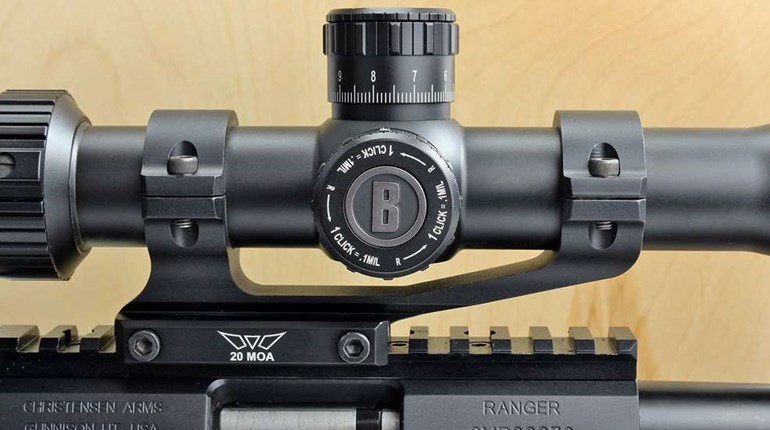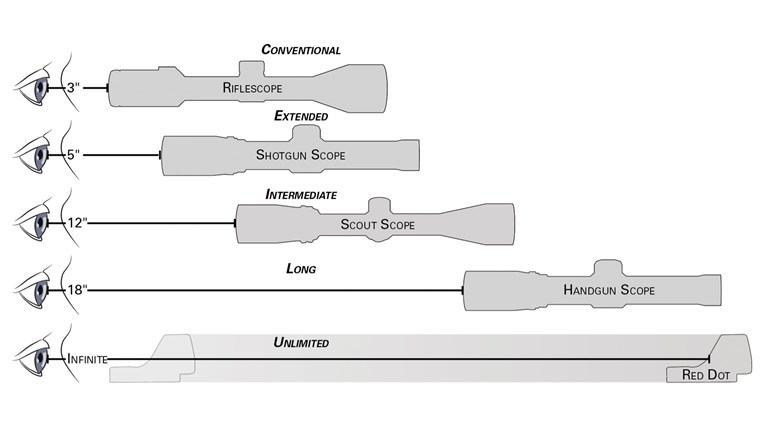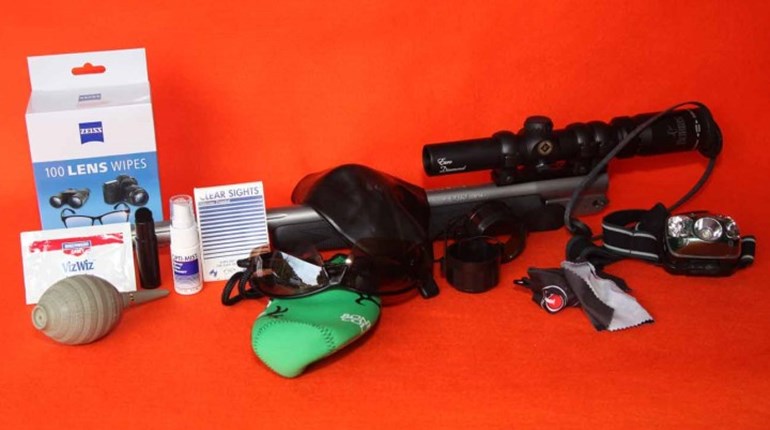
Windage and elevation adjustments in riflescopes are made with either internal or external adjustment systems. Here's what that means.
Internal: Most modern telescopic sights have internal adjustment systems using threaded, cylindrical knobs or screws in the turrets. The adjustment screws move the reticle assembly in the optical axis inside the main tube against spring pressure. The adjustment screws have clearly marked graduations around their circumference and many have a ball-detent system that clicks as the adjustment screws are turned. Each graduation or click represents a change in reticle position that moves the bullet strike at the target. This is expressed in minutes of angle (m.o.a.) and normally has a value of 1/2, 1/4 or 1/8 m.o.a. per click.
External: Many older scopes have an external-adjustment system built into the mounts and rings. Such scopes remain popular today for certain types of target competition. In this type of scope, the reticle remains stationary within the main tube and the point of the bullet strike is adjusted by mounts having micrometer windage and elevation mechanisms that move the entire scope laterally and/or vertically. These mounts often allow the scope to slide fore and aft to reduce recoil. An advantage of external-adjustment scopes is that the user is always sighting through the optical center of the tube.
As internal-adjustment systems became more reliable and more accurate, the popularity of external-adjustment scopes faded. Today, external-adjustment models are still offered, however the use of such scopes is now generally limited to a few specialized disciplines of rifle competition.
It is important to note that some scope-mounting systems designed for internal-adjustment scopes still incorporate the ability to accommodate some coarse external windage adjustment.
This leads us to the discussion of variable power. Variable-power riflescopes have an internal mechanism to change the amount of magnification within design limits. This consists of an additional set of lenses mounted in an internal tube that slides forward and rearward under the control of a cam attached to the magnification ring. The design of the lens system and its position in the tube controls the amount of magnification.
The popularity of variable-power riflescopes rests squarely on their flexibility. Variable magnification enables the shooter to adjsut the power to suit a wide variety of conditions ranging from lower power (with a wide field of view for fast shots at close range), to higher power (for greater precision at long range). Once considered expensive and unreliable, variable-power riflescopes have become the most popular type as their design has matured and prices have dropped. Todya, the single most popular riflescope is the 3-9X-40mm, which has become a kind of "jack of all trades." Smaller variables such as 2-7X-32mm remain popular for smaller-caliber rifles, while 4.5-12X-50mm and bigger models are favored for long-range shooting. Despite their flexibility, no one variable fits all applications and that is why there are so many different models.
Despite their popularity, variable-power riflescopes may suffer from certain drawbacks:
Internal: Most modern telescopic sights have internal adjustment systems using threaded, cylindrical knobs or screws in the turrets. The adjustment screws move the reticle assembly in the optical axis inside the main tube against spring pressure. The adjustment screws have clearly marked graduations around their circumference and many have a ball-detent system that clicks as the adjustment screws are turned. Each graduation or click represents a change in reticle position that moves the bullet strike at the target. This is expressed in minutes of angle (m.o.a.) and normally has a value of 1/2, 1/4 or 1/8 m.o.a. per click.
External: Many older scopes have an external-adjustment system built into the mounts and rings. Such scopes remain popular today for certain types of target competition. In this type of scope, the reticle remains stationary within the main tube and the point of the bullet strike is adjusted by mounts having micrometer windage and elevation mechanisms that move the entire scope laterally and/or vertically. These mounts often allow the scope to slide fore and aft to reduce recoil. An advantage of external-adjustment scopes is that the user is always sighting through the optical center of the tube.
As internal-adjustment systems became more reliable and more accurate, the popularity of external-adjustment scopes faded. Today, external-adjustment models are still offered, however the use of such scopes is now generally limited to a few specialized disciplines of rifle competition.
It is important to note that some scope-mounting systems designed for internal-adjustment scopes still incorporate the ability to accommodate some coarse external windage adjustment.
This leads us to the discussion of variable power. Variable-power riflescopes have an internal mechanism to change the amount of magnification within design limits. This consists of an additional set of lenses mounted in an internal tube that slides forward and rearward under the control of a cam attached to the magnification ring. The design of the lens system and its position in the tube controls the amount of magnification.
The popularity of variable-power riflescopes rests squarely on their flexibility. Variable magnification enables the shooter to adjsut the power to suit a wide variety of conditions ranging from lower power (with a wide field of view for fast shots at close range), to higher power (for greater precision at long range). Once considered expensive and unreliable, variable-power riflescopes have become the most popular type as their design has matured and prices have dropped. Todya, the single most popular riflescope is the 3-9X-40mm, which has become a kind of "jack of all trades." Smaller variables such as 2-7X-32mm remain popular for smaller-caliber rifles, while 4.5-12X-50mm and bigger models are favored for long-range shooting. Despite their flexibility, no one variable fits all applications and that is why there are so many different models.
Despite their popularity, variable-power riflescopes may suffer from certain drawbacks:
- The variable magnification system introduces another level of mechanical complexity and another source for optical error, potentially decreasing reliability.
- The movement of the internal components of a variable-power scope can produce changes in zero as the scope power is increased or decreased.
- Variable-power scopes are harder to seal than fixed-power scopes by virtue of the magnification-adjustment ring.
- As the magnification increases, the field of view and image brightness decrease, often substantially.
- Variable-magnification scopes are substantially heavier than fixed-power scopes.
- Variable-power scopes are more expensive than fixed-power scopes.







































